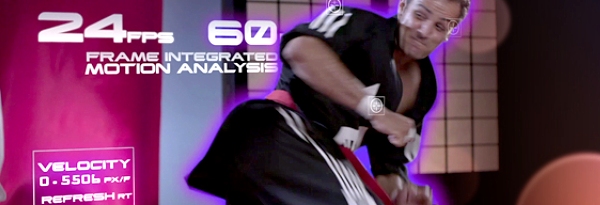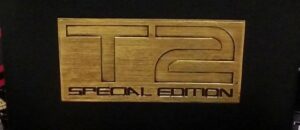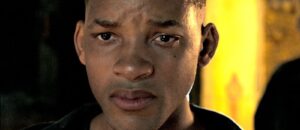A couple months ago, I posted the news that an audience test screening of footage from Peter Jackson’s upcoming ‘The Hobbit’ film was widely greeted with negative reactions, primarily due to the director’s experiment with shooting the movie at a higher 48 frames-per-second photographic rate. Viewers who’ve grown accustomed to the so-called “film look” of 24 fps photography over the decades found the more “video-like” appearance of the higher frame rate unnatural and disturbing. Now, visual effects pioneer Douglas Trumbull has invented his own high-frame-rate photographic process that may just solve this dilemma.
In addition to designing the legendary special effects for movies like ‘2001’ and ‘Blade Runner’, Trumbull is famous for the creation of a short-lived film format called Showscan that combined 65mm film with a high frame rate of 60 frames-per-second to achieve a heightened sense of realism. Showscan was used almost exclusively in theme park rides, not for narrative feature films. Even Trumbull himself acknowledged the limitations of shooting regular movies at higher frame rates. As quoted in a 2010 conference panel, Trumbull said:
I love high frame rates, because I like to make simulation rides and reality-based experiences that are looking to be as realistic as they possibly can, but 24 frames is what I call the “texture” of feature films. And I don’t think anybody’s really ready to see what you would categorize as a feature film shot at 60. And that was one of the tests I did when I was at Showscan; we shot a fully dramatic short film with sets, props, actors, the whole thing at 60 and it was very disturbing. Because it was like live news, or sports, or something.
However, directors like Peter Jackson and James Cameron are determined to press on with shooting movies at higher rates. In response, Trumbull has revived Showscan in a new variant called Showscan Digital that utilizes an extremely high native capture rate of 120 frames-per-second.
If audiences reacted negatively to the “video” look of 48 fps footage, wouldn’t 120 fps photography just be all that much worse? Not necessarily. In his words, Trumbull still recognizes that, “The whole world has adapted to 24 frames a second in a movie theater. That’s what a movie’s texture is like, what people expect.” As such, he’s designed Showscan Digital to be downconverted back to the standard 24 fps display rate upon playback.
So, what’s the point? By shooting the footage at 120 fps, Showscan Digital is able to capture sharp and crisp detail during motion that would normally blur at 24 fps. Using a technique called Frame Integrated Motion Analysis, that detail remains clear even when the extra frames are removed to convert back to 24 fps. Thus: “Showscan Digital automatically increases the clarity and the impact of fast action elements while preserving the world standard of 24 frames film texture.”
Here’s a promotional video that explains the concept in a little more detail:
One thing I like about this is the option of varying frame rate from scene to scene during production. This would allow a director to kick in the 120 fps clarity during, for example, action scenes, and then return to the standard 24 fps look during dramatic scenes, all while maintaining compatibility with the existing theatrical projection standard.
Does it really work the way that Trumbull describes? That will be hard to know until the process is put to practical use in a real movie production. The YouTube clip is too low-resolution to get a very good sense of the actual image quality. Still, the concept at least sounds plausible. I look forward to seeing it in action some day.
Too bad that it’s probably too late for Peter Jackson to reshoot ‘The Hobbit’ in this process.
[For more info, see the Showscan Digital web site. Thanks to Jason for the tip.]





JM
I wonder if 120 fps could help make certain art films feel like live theater?
EM
That might have been an interesting technique for Vanya on 42nd Street, for instance—not that it wasn’t an effective film to begin with.
It’s a different technique, but HD has brought something of a live-theater-like feel to the original Star Trek series. Sometimes I almost feel like I’m on the set. Yes, HD makes flaws in makeup, sets, etc. all the more apparent, but even in SD the best Star Trek episodes relied primarily on writing and acting to convince audiences of the program’s “reality”…much like a good stage play concerned more with personal conflict and philosophical questions than with scenery and props.
Luke Hickman
I would really like to see this with my own eyes. It sounds great.
Question: how much of ‘The Hobbit’ negative backlash could have stemmed from the film being unfinished? Is there a chance that it can look better after post?
Josh Zyber
AuthorYes, that’s possible. Jackson also argues that it will take viewers longer than 10 minutes to get used to the effect. If they sit and watch the whole thing, they’ll settle in with it after a while. Whether he’s right about that remains to be seen.
JM
High frame rate only seems to break the suspension of disbelief for actors and sets.
It improves action, nature shots, and CGI characters.
I’m expecting ‘The Hobbit’ reviews to be mixed, praising/hating along those lines.
The dragon and war sequences might be fantastic.
Luke Hickman
I remember the initial reports of the 48-fps requiring new digital projectors. What ever happened with that? The issue seemed to disappear. Can this be achieved with software upgrades?
JM
1st gen digital projectors can’t do 48fps.
2nd gen can do up to 144fps, and only need a firmware upgrade.
‘The Hobbit’ will have 10,000+ projectors at 48fps when it releases.
Mike Attebery
Half the magic of film comes from it not looking like reality. Messing with the frame rate is just stupid. They should spend the extra time and money perfecting their scripts.
JM
How would extra time and money lead to more perfect scripts?
Mike
Spending more time on scripts and allowing extra time for rewrites (paying the writers while they hone the script), THAT’S how time and money equal better scripts. Pretty simple.
JM
The purpose of film is to generate emotion in the audience.
Douglas Trumbull discovered that higher frame rates significantly amplify the intensity of the emotion of the scene.
24, 48, 60, 120. The higher the frame rate, the greater the excitement.
120 fps didn’t even appear to be the intensity ceiling, but he didn’t have a faster projector to experiment with.
Action movie directors will use this technology to compensate for the weakness of the script, and evolve movies closer to roller coaster rides.
Imagine ‘The Raid’ at 8K, 120 fps.
EM
Why isn’t George Lucas all over this technology? “Faster!” “More intense!”
motorheadache
I’m sure after 3D he’ll convert all six Star Wars films to 120fps. It’ll involve copying each frame and then slightly modifying it with computers to simulate the effect or something.
Because he always wanted the films to have a higher frame rate, but he was limited by the technology at the time.
EM
Maybe he could simply play them back sped up 5×. They’d be much shorter, but they’d be faster and more instense, and the prequels would probably be much more bearable.
William Henley
Frame interpolation is not that hard to do. 120Hz televisions already do this to some extent.
Mike
And they make things look horrendous.
William Henley
This makes sense. I have actually been shooting stuff with my camera over the past two years at 120 or 240fps when I do high action stuff and speed it up to 30fps in Premiere for this very reason. I honestly thought they had been doing this for years – I have seen many “making of” features where they actually talk about shooting crashes and stuff at higher framerates and then playing them back at higher speeds to get crisper images.
The idea, though, that a movie can have both 24fps and 60fps in the same movie is actually a really cool idea.
Sadly, this video sucks. its 360p, and of course, YouTube I think limits your framerate to 30fps. So in the video, we don’t get to see the clarity, or the advantage of either 24 or 60, and certainly don’t get to see 120. Sigh.